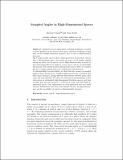Files in this item
Sampled angles in high-dimensional spaces
Item metadata
| dc.contributor.author | Connor, Richard | |
| dc.contributor.author | Dearle, Al | |
| dc.contributor.editor | Satoh, Shin'ichi | |
| dc.contributor.editor | Vadicamo, Lucia | |
| dc.contributor.editor | Zimek, Arthur | |
| dc.contributor.editor | Carrara, Fabio | |
| dc.contributor.editor | Bartolini, Ilaria | |
| dc.contributor.editor | Aumüller, Martin | |
| dc.contributor.editor | Jónsson, Björn Þór | |
| dc.contributor.editor | Pagh, Rasmus | |
| dc.date.accessioned | 2020-11-11T15:30:14Z | |
| dc.date.available | 2020-11-11T15:30:14Z | |
| dc.date.issued | 2020 | |
| dc.identifier | 270188610 | |
| dc.identifier | 8ef1de29-6808-49e0-ab69-a054cfdd49d3 | |
| dc.identifier | 85093852620 | |
| dc.identifier | 000616694200018 | |
| dc.identifier.citation | Connor , R & Dearle , A 2020 , Sampled angles in high-dimensional spaces . in S Satoh , L Vadicamo , A Zimek , F Carrara , I Bartolini , M Aumüller , B Þ Jónsson & R Pagh (eds) , Similarity Search and Applications : 13th International Conference, SISAP 2020, Copenhagen, Denmark, September 30–October 2, 2020, Proceedings . Lecture Notes in Computer Science (Information Systems and Applications, incl. Internet/Web, and HCI) , vol. 12440 , Springer , Cham , pp. 233-247 , 13th International Conference on Similarity Search and Applications, SISAP 2020 , 30/09/20 . https://doi.org/10.1007/978-3-030-60936-8_18 | en |
| dc.identifier.citation | conference | en |
| dc.identifier.isbn | 9783030609351 | |
| dc.identifier.isbn | 9783030609368 | |
| dc.identifier.issn | 0302-9743 | |
| dc.identifier.uri | https://hdl.handle.net/10023/20953 | |
| dc.description.abstract | Similarity search using metric indexing techniques is largely a solved problem in low-dimensional spaces. However techniques based only on the triangle inequality property start to fail as dimensionality increases. Since proper metric spaces allow a finite projection of any three objects into a 2D Euclidean space, the notion of angle can be validly applied among any three (but no more) objects. High dimensionality is known to have interesting effects on angles in vector spaces, but to our knowledge this has not been studied in more general metric spaces. Here, we consider the use of angles among objects in combination with distances. As dimensionality becomes higher, we show that the variance in sampled angles reduces. Furthermore, sampled angles also become correlated with inter-object distances, giving different distributions between query solutions and non-solutions. We show the theoretical underpinnings of this observation in unbounded high-dimensional Euclidean spaces, and then examine how the pure property is reflected in some real-world high dimensional spaces. Our experiments on both generated and real world datasets demonstrate that these observations can have an important impact on the tractability of search as dimensionality increases. | |
| dc.format.extent | 1882626 | |
| dc.language.iso | eng | |
| dc.publisher | Springer | |
| dc.relation.ispartof | Similarity Search and Applications | en |
| dc.relation.ispartofseries | Lecture Notes in Computer Science (Information Systems and Applications, incl. Internet/Web, and HCI) | en |
| dc.subject | Metric search | en |
| dc.subject | High dimensional space | en |
| dc.subject | QA75 Electronic computers. Computer science | en |
| dc.subject | DAS | en |
| dc.subject | BDC | en |
| dc.subject.lcc | QA75 | en |
| dc.title | Sampled angles in high-dimensional spaces | en |
| dc.type | Conference item | en |
| dc.contributor.institution | University of St Andrews. School of Computer Science | en |
| dc.identifier.doi | https://doi.org/10.1007/978-3-030-60936-8_18 | |
| dc.date.embargoedUntil | 2020-11-11 | |
| dc.identifier.url | https://www.springer.com/gp/book/9783030609351 | en |
This item appears in the following Collection(s)
Items in the St Andrews Research Repository are protected by copyright, with all rights reserved, unless otherwise indicated.

